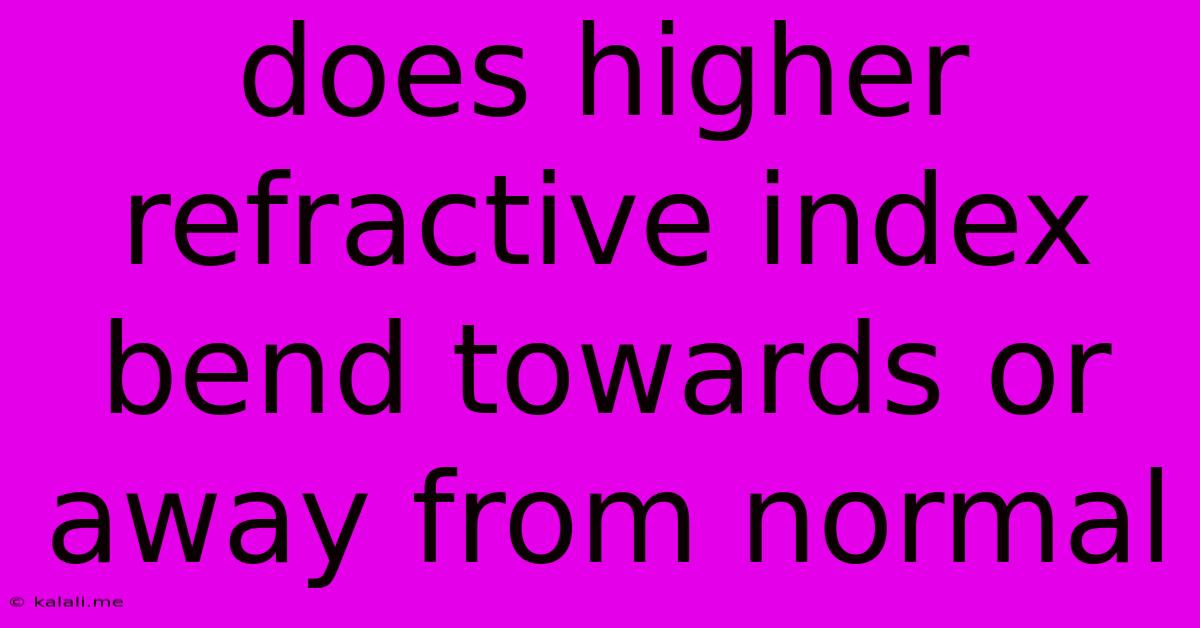Does Higher Refractive Index Bend Towards Or Away From Normal
Kalali
Jun 07, 2025 · 3 min read

Table of Contents
Does Higher Refractive Index Bend Towards or Away from the Normal?
Understanding how light bends when passing through different mediums is crucial in optics and various related fields. This article will explore the relationship between refractive index and the bending of light, specifically addressing whether light bends towards or away from the normal when encountering a medium with a higher refractive index. We'll delve into Snell's Law and provide practical examples to solidify your understanding.
Snell's Law: The Guiding Principle
The bending of light, also known as refraction, is governed by Snell's Law. This law states that the ratio of the sines of the angles of incidence and refraction is equal to the ratio of the refractive indices of the two media. Mathematically, it's represented as:
n₁sinθ₁ = n₂sinθ₂
Where:
n₁is the refractive index of the first mediumθ₁is the angle of incidence (angle between the incident ray and the normal)n₂is the refractive index of the second mediumθ₂is the angle of refraction (angle between the refracted ray and the normal)
Higher Refractive Index: Bending Towards the Normal
When light travels from a medium with a lower refractive index to a medium with a higher refractive index (e.g., from air to glass), the light bends towards the normal. This is because the speed of light is slower in the denser medium (higher refractive index). The change in speed causes the light to deviate from its original path, resulting in a smaller angle of refraction compared to the angle of incidence.
Lower Refractive Index: Bending Away from the Normal
Conversely, when light travels from a medium with a higher refractive index to a medium with a lower refractive index (e.g., from glass to air), the light bends away from the normal. In this case, the speed of light increases as it enters the less dense medium, causing the light to deviate further from the normal, resulting in a larger angle of refraction.
Practical Examples
-
Looking into a swimming pool: The water in the pool has a higher refractive index than air. As light travels from the water to your eyes, it bends towards the normal, making the pool appear shallower than it actually is.
-
A pencil in a glass of water: A pencil partially submerged in water appears bent at the water's surface. This is due to the refraction of light as it passes from the water (higher refractive index) into the air (lower refractive index), bending away from the normal.
-
Prisms and Spectroscopy: Prisms utilize the principle of refraction to separate white light into its constituent colors. The different wavelengths of light bend at slightly different angles due to their varying refractive indices in the prism material.
Understanding Critical Angle and Total Internal Reflection
When light travels from a higher refractive index medium to a lower refractive index medium, there's a specific angle of incidence known as the critical angle. If the angle of incidence exceeds the critical angle, total internal reflection occurs, meaning that all the light is reflected back into the higher refractive index medium. This phenomenon is essential in fiber optics and other optical technologies.
Conclusion
In summary, light bends towards the normal when passing from a medium with a lower refractive index to one with a higher refractive index. The opposite is true when light passes from a higher to a lower refractive index medium; the light bends away from the normal. Snell's Law provides the mathematical framework for understanding this fundamental principle of optics, with practical implications across numerous scientific and technological applications. Understanding this concept is crucial for anyone studying physics, engineering, or any field that utilizes optical principles.
Latest Posts
Latest Posts
-
Fallout 4 Leave Dogmeat At Home
Jun 07, 2025
-
How To Replace A Fireplace Insert
Jun 07, 2025
-
Wifi Says Saved Secured But Wont Connect
Jun 07, 2025
-
Which Experiment Deduced Charge On Electron
Jun 07, 2025
-
Why Didnt A Itachikill His Own Clan
Jun 07, 2025
Related Post
Thank you for visiting our website which covers about Does Higher Refractive Index Bend Towards Or Away From Normal . We hope the information provided has been useful to you. Feel free to contact us if you have any questions or need further assistance. See you next time and don't miss to bookmark.